| Pages:
1
..
21
22
23
24
25 |
James Ikanov
Hazard to Self
 
Posts: 81
Registered: 12-7-2015
Location: Alaska
Member Is Offline
Mood: Zen
|
|
Something interesting I just read that may apply to those of you using MnO2 type thermites....
https://medicine.wustl.edu/news/low-levels-manganese-welding...
I'm not sure if it's relevant to everyone or even anyone but it seems like something worth throwing out there where it's visible for anyone it might
effect.
“To do good work one must eat well, be well housed, have one's fling from time to time, smoke one's pipe, and drink one's coffee in peace” -
Vincent Van Gogh
|
|
|
tsathoggua1
Hazard to Others
  
Posts: 335
Registered: 8-1-2017
Location: Beyond the pale
Member Is Offline
Mood: Phosphorescent
|
|
Has anyone experience with Mn(OH)2-Mg or Mn(OH)2/Al thermites? Been wanting to reduce some manganese hydroxide using either Mg fine dust or have some
<~30 micron Al. Is this known to be violent or explosive? because a slower burn is desired in order to trap the results in a crucible whilst
burning and retain the Mn, the point of the exercise.
Likewise, with these reductants and colloidal SiO(H)2.
|
|
|
PHILOU Zrealone
International Hazard
    
Posts: 2893
Registered: 20-5-2002
Location: Brussel
Member Is Offline
Mood: Bis-diazo-dinitro-hydroquinonic
|
|
Quote: Originally posted by tsathoggua1  | Has anyone experience with Mn(OH)2-Mg or Mn(OH)2/Al thermites? Been wanting to reduce some manganese hydroxide using either Mg fine dust or have some
<~30 micron Al. Is this known to be violent or explosive? because a slower burn is desired in order to trap the results in a crucible whilst
burning and retain the Mn, the point of the exercise.
Likewise, with these reductants and colloidal SiO(H)2. |
The idea to use hydroxides into Al or Mg thermites is for obvious reasons extremely dangerous...
-->hot burning composition (>2000°C) + water as product = explosion of H2O (gas) spreading burning red hot metal all over the place and at a
relatively big distance...
PH Z (PHILOU Zrealone)
"Physic is all what never works; Chemistry is all what stinks and explodes!"-"Life that deadly disease, sexually transmitted."(W.Allen)
|
|
|
tsathoggua1
Hazard to Others
  
Posts: 335
Registered: 8-1-2017
Location: Beyond the pale
Member Is Offline
Mood: Phosphorescent
|
|
Decided to roast it, thanks for the quick tip.
Anyone ever done an MnO2 thermite? Question is, due to the reactivity of Mn, will it survive, and would a (lidded) carbon crucible survive the
experience? and how difficult is it to ignite? I've always found bog standard Fe oxide/Al type thermites rather difficult to get going.
Mainly asking due to the rather odd reactivity of copper oxide thermites, Mn being a somewhat out of the usual range, I'd like some idea of its
reactivity before initiation. The end goal is actually collecting the Mn, rather than simply a pyrotechnic display.
Would addition of a little sulfur to a small surface area suffice to allow initiation from the outside (assuming the lid is tightly clamped on, with a
bit of disposable crap wood to avoid melting the clamp (these have copper plated steel end plates, ideally initiation from the outside of the crucible
would be good, elsewise I'd have to initiate it with a piece of Li strip meaning gutting a battery (I've got some better quality Li, but thats kept in
a sealed bag of inert gas, presumably argon, in a jar containing some anhydrous CaCl2 and Mg powder to absorb H2O and oxygen respectively, most of it
already having been displaced with dry argon. And I'd sooner not open that, I'm saving it for the next time a large birch-benkeser reduction is on the
menu, or something similar, so all 20-25g can be used at once, storage being a pain in the ass.
I find the foils in batteries work well for initiating thermites, and damned if I don't have a huge bag full of e-fag batteries that have gone down
the shitter, so to speak. Damn things have a remarkably high attrition rate. Although at least when they fail charged they are good recycling
material. (as if I haven't spent enough time filleting batteries of late, was up all night last night doing just that)
[Edited on 16-4-2017 by tsathoggua1]
|
|
|
Bert
Super Administrator
        
Posts: 2821
Registered: 12-3-2004
Member Is Offline
Mood: " I think we are all going to die. I think that love is an illusion. We are flawed, my darling".
|
|
If you ignite an Aluminum/Manganese dioxide thermite in a sealed crusible, it will probably EXPLODE.
The Manganese comes off as a GAS. Not a well mannered liquid metal- LOTS of very HOT gas, you can use this reaction as a rocket fuel with an ISP
similar to black powder.
There are descriptions of techniques that have been used by a member to collect Manganese metal from such reductions posted here, search a bit.
Rapopart’s Rules for critical commentary:
1. Attempt to re-express your target’s position so clearly, vividly and fairly that your target says: “Thanks, I wish I’d thought of putting it
that way.”
2. List any points of agreement (especially if they are not matters of general or widespread agreement).
3. Mention anything you have learned from your target.
4. Only then are you permitted to say so much as a word of rebuttal or criticism.
Anatol Rapoport was a Russian-born American mathematical psychologist (1911-2007).
|
|
|
tsathoggua1
Hazard to Others
  
Posts: 335
Registered: 8-1-2017
Location: Beyond the pale
Member Is Offline
Mood: Phosphorescent
|
|
Did it in the open, and wasn't greatly surprised to find that there wasn't a collectible quantity of elemental manganese. I don't do pyro, can't
afford to get clocked doing that stuff, the thermite rxn is more or less an exception, used for E.g cutting, welding, and harvesting metals from
oxides.
MnO2/Mg proved too difficult to ignite on its own, but the mixture, sensitized with a little sulfur in a localized area (the idea being the thermate
ignites the thermite with as little sulfur/sulfide contamination as possible) does indeed go off bloody fast. Hadn't quite realized HOW fast though.
MnO2/Mg/S thermate goes off like flash powder and is sensitive enough to ignite with a blowtorch flame exposure for a second or two, yet MnO2/Mg
(can't remember the mesh size, but fairly fine.
Another attempt made was pyrolysis of manganese formate and acetate in an argon-purged stoppered tube in the hope of forming something akin to
pyeophorus of lead or pyrophoric iron nanopowder akin to the products of pyrolyzing the corresponding tartrates (didn't have any tartaric acid to hand
so I went with the formate and acetate salts. Next, the ascorbate will be tried, Vit.C being a reducing agent might help, would be interesting to try
anyway. As will the cutrate,
Acrid fumes were driven off under heating in the air of a sample, whilst a dark, tarry substance, doubtless generic organic residues from pyrolysis of
the organic portion of the salt, but no luck, even when heated sufficiently to break the test tube (I've another order coming of test tubes and this
one was intractably mucky so sacrificing it was fine,
|
|
|
tsathoggua1
Hazard to Others
  
Posts: 335
Registered: 8-1-2017
Location: Beyond the pale
Member Is Offline
Mood: Phosphorescent
|
|
Interesting that people say PbO2/Al thermites are meant to be energetic, U dud use it in a thermite once, ignition with a strip of lithium foil in
lieu of magnesium as a fuse, and it was decidedly sluggish, onlu a few sparks and a slow, dull red glowing reduction giving elemental lead
|
|
|
Elemental Phosphorus
Hazard to Others
  
Posts: 185
Registered: 11-11-2016
Location: Is everything
Member Is Offline
Mood: No Mood
|
|
Strange problem with MgAl-red iron oxide thermite
Today I ignited about 600 milligrams of thermite made with 200-325 mesh magnalium and red iron oxide (pottery grade, extremely fine, I can post a
photo if necessary). Much to my surprise, it did not deflagarate like traditional Fe2O3/Al thermite, rather it deflagarated extremely fast (for
thermite, slower than flash powder), and on analysis of the video the flash lasts ~8 frames. Can anyone provide insight as to why this happened? I
mean, 4 of the frames are a completely yellow-white screen. That is simply not consistent with what I have seen of iron oxide thermite. Any comments?
Thanks.
|
|
|
ShotBored
Hazard to Others
  
Posts: 124
Registered: 19-5-2017
Location: Germany
Member Is Offline
Mood: No Mood
|
|
What was your ratio of mag-al to Fe2O3?
|
|
|
Elemental Phosphorus
Hazard to Others
  
Posts: 185
Registered: 11-11-2016
Location: Is everything
Member Is Offline
Mood: No Mood
|
|
250 milligrams of magnalium and 350 milligrams of red iron oxide.
|
|
|
greenlight
National Hazard
   
Posts: 737
Registered: 3-11-2014
Member Is Offline
Mood: Energetic
|
|
I have done some tests with magnalium thermite before and took photos.
I had a similar ratio to the one you list to start and it deflagrated very fast mainly throwing red hot metal all around and slightly charring what it
was in contact with.
Results from testing in 5 gram amounts were:
2:1 Fe2o3:Mg/Al = Slightly slower but still too fast burning. Nearly no slag left.
3:1 Fe2o3:Mg/Al = Much slower burn rate 3 seconds) leaving some red hot slag.
4:1 Fe2o3:Mg/Al = Even slower burntime (5-6 seconds) leaving a lot of red hot slag behind.
I found it to be about perfect between the two last ratios. Here are two pictures of the tests midburn that I found. The left is the ratio similar
to yours and the right is about 4g iron oxide to 1.2g Mg/Al.
[Edited on 25-5-2017 by greenlight]
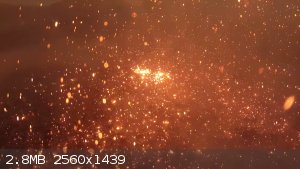 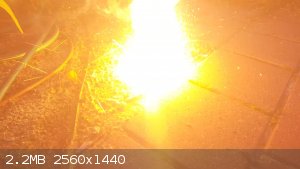
[Edited on 25-5-2017 by greenlight]
Be good, otherwise be good at it 
|
|
|
PHILOU Zrealone
International Hazard
    
Posts: 2893
Registered: 20-5-2002
Location: Brussel
Member Is Offline
Mood: Bis-diazo-dinitro-hydroquinonic
|
|
Quote: Originally posted by Elemental Phosphorus  | | Today I ignited about 600 milligrams of thermite made with 200-325 mesh magnalium and red iron oxide (pottery grade, extremely fine, I can post a
photo if necessary). Much to my surprise, it did not deflagarate like traditional Fe2O3/Al thermite, rather it deflagarated extremely fast (for
thermite, slower than flash powder), and on analysis of the video the flash lasts ~8 frames. Can anyone provide insight as to why this happened? I
mean, 4 of the frames are a completely yellow-white screen. That is simply not consistent with what I have seen of iron oxide thermite. Any comments?
Thanks. |
Magnesium si more reactive than Aluminium so the mix ignites faster and easier...the activation energy is thus lower.
Magnesium burns brighter than Aluminium so your photo or video camera sensor did a (over)saturation of its sensor and had not the time to adapt for
brightness.
PH Z (PHILOU Zrealone)
"Physic is all what never works; Chemistry is all what stinks and explodes!"-"Life that deadly disease, sexually transmitted."(W.Allen)
|
|
|
Elemental Phosphorus
Hazard to Others
  
Posts: 185
Registered: 11-11-2016
Location: Is everything
Member Is Offline
Mood: No Mood
|
|
That makes sense, thanks. I was going to guess that since I had not previously dried the red iron oxide, it was a steam explosion. But that didn't
really make sense, since there was a very bright flash, and the oxide didn't seem *too* wet. I'll post some freeze-frames later today. Anyhow, I'm
glad I only made 600 milligrams, since I did not expect a fast deflagaration. I suppose that I can take away the lesson to always test any sort of
pyrotechnics or energetic compositions in small quantities.
|
|
|
PHILOU Zrealone
International Hazard
    
Posts: 2893
Registered: 20-5-2002
Location: Brussel
Member Is Offline
Mood: Bis-diazo-dinitro-hydroquinonic
|
|
Quote: Originally posted by Elemental Phosphorus  | | That makes sense, thanks. I was going to guess that since I had not previously dried the red iron oxide, it was a steam explosion. But that didn't
really make sense, since there was a very bright flash, and the oxide didn't seem *too* wet. I'll post some freeze-frames later today. Anyhow, I'm
glad I only made 600 milligrams, since I did not expect a fast deflagaration. I suppose that I can take away the lesson to always test any sort of
pyrotechnics or energetic compositions in small quantities. |
Yes prior small testing is a must not only once, but everytime a parameter changes...moisture, new ingredient or batch, different mesh, different
temperature, different confinement,...
And when scaling up...it is a good idea to do it by slow increments for safety considerations...even a simple scaling up factor 2 has lead to
casualities onto industrial plants or on lab reactions process...via unsuspected side-reactions with a lower minor thermodynamic kinetic at one scale
but higher and major at double scale...
PH Z (PHILOU Zrealone)
"Physic is all what never works; Chemistry is all what stinks and explodes!"-"Life that deadly disease, sexually transmitted."(W.Allen)
|
|
|
Elemental Phosphorus
Hazard to Others
  
Posts: 185
Registered: 11-11-2016
Location: Is everything
Member Is Offline
Mood: No Mood
|
|
Photos, as promised
Here are the photos, as I promised:
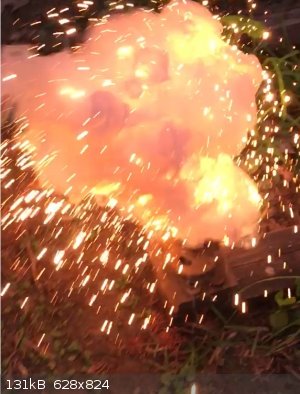 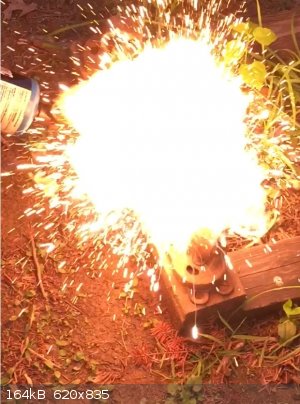 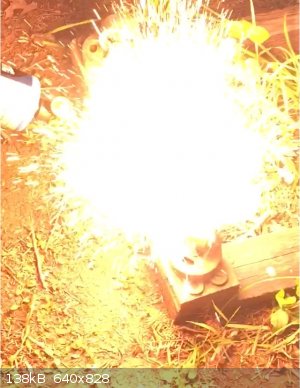 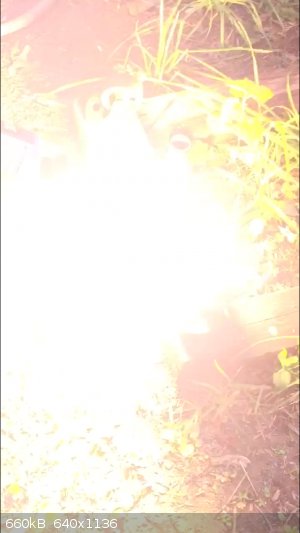
Edit: I chose to omit the entirely white frames since those don't really help.
[Edited on 25-5-2017 by Elemental Phosphorus]
|
|
|
Dornier 335A
Hazard to Others
  
Posts: 231
Registered: 10-5-2013
Location: Northern Europe
Member Is Offline
Mood: No Mood
|
|
There's another important difference between magnesium and aluminium: the boiling point. Al boils at 2470°C and Mg at 1091°C, which means that
magnesium based thermites produce gas unlike aluminium based ones.
|
|
|
kratomiter
Hazard to Others
  
Posts: 106
Registered: 30-9-2012
Member Is Offline
Mood: No Mood
|
|
Magnalium/Sm2O3 thermite
Here is a photo of a magnalium/Sm2O3 thermite. It burns slowly with a strong white light light, leaving a surface of what seems Al/Mg/Sm oxide (it
gets oxidized easily when exposed in the air) and samarium dust inside. Also it emits white fumes, maybe Samarium?
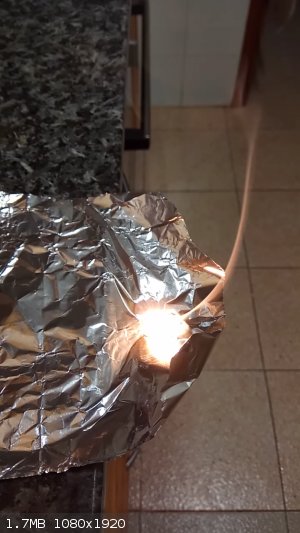
[Edited on 6-7-2017 by kratomiter]
|
|
|
Deluxbert
Harmless

Posts: 13
Registered: 24-4-2017
Member Is Offline
Mood: Skurr Skurr
|
|
MnO2 + Mg is another one of those "Thermites" that explode more than they burn. Never tried using Al but thats a possible way to get Manganese metal.
And like James Ikanov said. Breathing in Manganese is no good. It makes orange mushroom clouds.
[Edited on 19-1-2018 by Deluxbert]
|
|
|
Alidada
Harmless

Posts: 1
Registered: 8-11-2018
Member Is Offline
|
|
Hi everyone.
I am interested in ways you can make glass out of other chemicals and how you can join it with chemical reactions.
Chemical reactions for joining that I am thinking about are thermite reactions.
I did find some articles about using nanothermite in joining non similar materials.
Could there be some additives that you can add to Al/SiO2 thermite mix so that Silicon produced oxidizes and will not form elemental silicon?
Reason I want to do this is that I want to produce glass microfluidic chips.
|
|
|
j_sum1
Administrator
       
Posts: 6320
Registered: 4-10-2014
Location: At home
Member Is Offline
Mood: Most of the ducks are in a row
|
|
Welcome to SM, alidada.
Your question is not really a thermite question. Glass is an oxide and, as such, is a potential reactant rather than the product of a thermite.
My recommendation is to search the board and see what you can find that relates to your question. If you don't find the answers you seek, it would be
better to start a new thread.
|
|
|
wg48
National Hazard
   
Posts: 821
Registered: 21-11-2015
Member Is Offline
Mood: No Mood
|
|
Quote: Originally posted by Alidada  | Hi everyone.
I am interested in ways you can make glass out of other chemicals and how you can join it with chemical reactions.
Chemical reactions for joining that I am thinking about are thermite reactions.
I did find some articles about using nanothermite in joining non similar materials.
Could there be some additives that you can add to Al/SiO2 thermite mix so that Silicon produced oxidizes and will not form elemental silicon?
Reason I want to do this is that I want to produce glass microfluidic chips. |
The slag produced by common thermites is a form of glass. I guess it would be possible to adjust the composition of the slag by adjusting the
composition of the starting materials. So to get a soda lime glass the thermite would have to start from sodium and calcium metal, silicon (or the
oxide) and iron oxide as the oxidant. The slag (glass) would float on top of molten iron. There are probably other types of glass that would be more
compatible with the thermite process. However the slag tends to cool quickly and trap gas bubbles and fracture. It would also be contaminated by iron.
Its probably not impossible to do with lots of experimentation.
If your just wanting to glue glass sheets together and need the chemical resistance of glass then fusing or ceramic glues can be used. There are also
lots organic glues specific for glass including UV cured types if such organics are compatible with your fluidics.
Borosilicate glass:
Good temperature resistance and good thermal shock resistance but finite.
For normal, standard service typically 200-230°C, for short-term (minutes) service max 400°C
Maximum thermal shock resistance is 160°C
|
|
|
Ghass1974
Harmless

Posts: 8
Registered: 25-7-2018
Member Is Offline
|
|
Thermite Pellet Forming
Hello everyone,
I am new to this topic. I am looking for a Teflon Resin that comes in a liquid form then upon mixing with thermite ingredients such as iron oxide and
aluminum, with a hardener; it will harden to a pellet.
Is there a PTFE resin that I can use, if not , is there anything else?
Thank you
Ghass
|
|
|
Rocinante
Hazard to Others
  
Posts: 121
Registered: 13-11-2017
Member Is Offline
Mood: No Mood
|
|
Has anyone any experience with a thermite mixture that burns hot (above 1500°C) has sufficient energy density (above 2.5 kJ/g and at least 7 kJ when
pressed close to 3 g/cm^3) while producing a very viscous/semi-molten mass?
My first guess/attempt would/will be SiO2/Fe2O3 thermite 1:1 pressed close to 3 g/cm3 if possible.
The goal is to produce pellets that have high steel melting/damaging capability. While regular thermite can be pressed to impressive 4.9 g/cm3 (loose
powder has 0.7) and energy density above 20 kJ/cm3 and low burning speed of 4 mm/s with little spray - it has one draw back - the molten iron is quite
liquid and it tends to pour quickly out of the first hole it creates, thus having not-so-great anti-steel capability.
|
|
|
MineMan
International Hazard
    
Posts: 1004
Registered: 29-3-2015
Member Is Offline
Mood: No Mood
|
|
A thermite with silicon as a fuel? Since silicon will oxidize into SIO2. Good question man. That’s a tough one. Can you describe the purpose more?
Will these be shot at the steel?
All anti armor munitions are made to just punch a hole really... have no idea how you would damage a large area of steel.
[Edited on 18-4-2019 by MineMan]
|
|
|
Rocinante
Hazard to Others
  
Posts: 121
Registered: 13-11-2017
Member Is Offline
Mood: No Mood
|
|
No. I mean SiO2/Al + Fe2O3/Al mixture, 50:50 by mass.
Sillicon thermite is notoriously solid and difficult to ignite because it burns only around 1700°C and the sillicon produced freezes into solid at
1500°C which would be ideal for my purpose but the energy density is low (2000 kJ/kg, about 4000 J/cm3) compared to 12 kJ/cm3 for only mildly (3
g/cm3) pressed Fe2O3 thermite
I envision two applications, a heating pellet 4 cm in diamater inside a heat resistant casing placed on a piece of steel and a wide-flange column
destroyer, an [ shaped piece of heat resistant casing is placed between the flanges of the column and the mixture heats it to failure (850 degrees and
above for a short section), however the mixture needs to be solid enough not to pour out of the bottom once the column starts to - slightly - deform
(650°C).
I'm going to try the 50:50 mixture in the next few weeks, anyway I though about 25 % SiC and 75 % normal thermite, a large part of the SiC shoudl
survive at the burn front in a solid state - giving the iron more of a gel form (I hope).
|
|
|
| Pages:
1
..
21
22
23
24
25 |